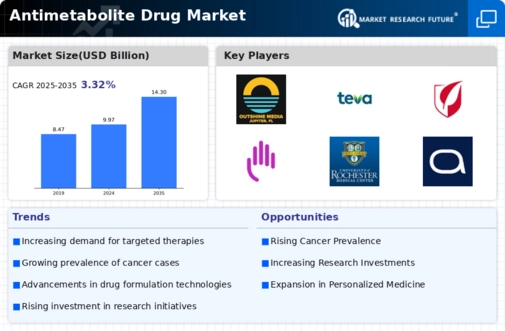The Antimetabolite Drug Market is characterized by a dynamic competitive landscape, driven by a confluence of innovation, strategic partnerships, and regional expansions. Key players such as Roche (CH), Merck & Co. (US), and Bristol-Myers Squibb (US) are at the forefront, each adopting distinct strategies to enhance their market positioning. Roche (CH) emphasizes innovation in drug development, particularly in personalized medicine, while Merck & Co. (US) focuses on expanding its global footprint through strategic collaborations. Bristol-Myers Squibb (US) is actively pursuing mergers and acquisitions to bolster its portfolio, particularly in oncology, which is a significant growth area for antimetabolite therapies. Collectively, these strategies not only enhance their competitive edge but also shape the overall market dynamics, fostering an environment ripe for advancements in treatment options.
In terms of business tactics, companies are increasingly localizing manufacturing to reduce costs and improve supply chain efficiency. This approach is particularly relevant in the context of the Antimetabolite Drug Market, which is moderately fragmented, with several players vying for market share. The collective influence of these key players is substantial, as they leverage their operational strengths to optimize production and distribution channels, thereby enhancing their competitive positioning.
In August 2025, Roche (CH) announced a strategic partnership with a leading biotechnology firm to co-develop a novel antimetabolite drug aimed at treating specific types of cancer. This collaboration is significant as it not only expands Roche's pipeline but also underscores its commitment to innovation in targeted therapies. The partnership is expected to accelerate the development process, allowing Roche to maintain its competitive edge in a rapidly evolving market.
Similarly, in July 2025, Merck & Co. (US) launched a new initiative focused on digital health solutions to complement its antimetabolite offerings. This initiative aims to integrate digital tools into patient care, enhancing treatment adherence and outcomes. The strategic importance of this move lies in its potential to differentiate Merck's products in a crowded marketplace, aligning with the growing trend towards personalized medicine and patient-centric approaches.
Furthermore, in September 2025, Bristol-Myers Squibb (US) completed the acquisition of a smaller biotech company specializing in next-generation antimetabolite therapies. This acquisition is pivotal as it not only expands Bristol-Myers Squibb's product portfolio but also enhances its research capabilities in oncology. The integration of innovative technologies from the acquired firm is likely to bolster Bristol-Myers Squibb's competitive position in the market, particularly as the demand for advanced cancer therapies continues to rise.
As of October 2025, the Antimetabolite Drug Market is witnessing trends that emphasize digitalization, sustainability, and the integration of artificial intelligence in drug development. Strategic alliances are increasingly shaping the competitive landscape, enabling companies to pool resources and expertise. Looking ahead, it appears that competitive differentiation will evolve from traditional price-based strategies to a focus on innovation, technological advancements, and supply chain reliability. This shift suggests that companies that prioritize these elements will likely emerge as leaders in the Antimetabolite Drug Market.
























Leave a Comment